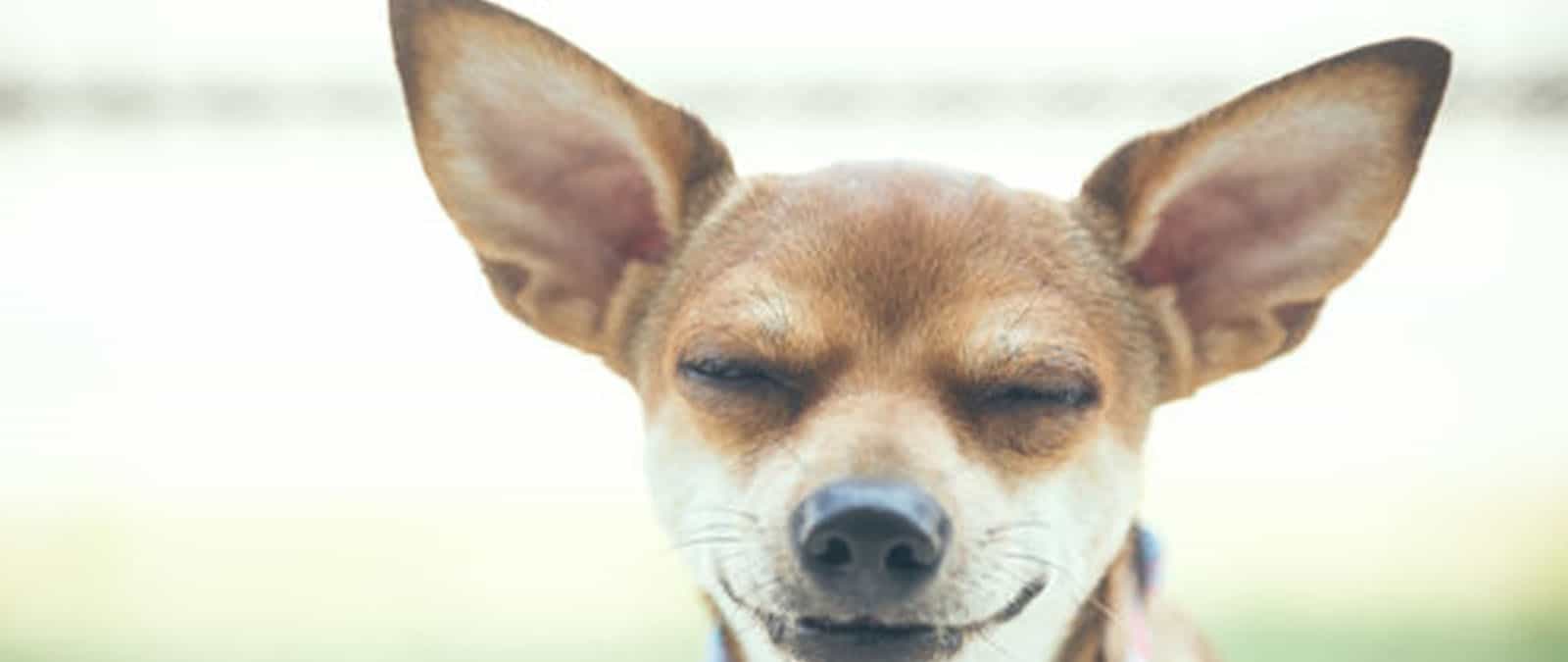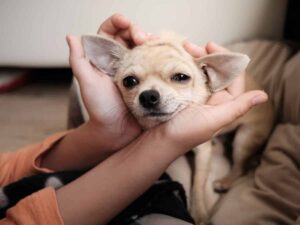We all know why Dumbo has giant ears, but why do Chihuahuas have big ears?
Great question 😉
In this article, you’ll find out the answer.

Read on to discover:
- If all Chihuahuas have big ears.
- How to understand what your Chi’s ears are saying (fun fact: they can ‘talk’).
- And more…
Why do Chihuahuas have big ears?
The reasons Chihuahuas have large ears have to do with their ancestors. These desert dogs developed big ears for a few important purposes: to have shade from the sun, to collect moisture, to serve as protection for puppies, and to communicate.
The big ears are almost parasol-like. The size and shape protect the desert dog from the sun’s rays.
Chihuahua ears’ large size and distinctive shape also collect moisture from the air, and this is a unique feature not found in most other breeds.
The moisture condenses through the skin throughout the day, providing the Chihuahua with life-saving water.
When Chihuahuas are pups, their mother’s large ears protect them from the sun’s rays and warmth during the cold nights and winter.
Lastly, Chihuahua ears are communication tools. Each ear has 18 muscles, allowing them to be easily maneuvered and signal a variety of feelings. This is important in the wild as well as in the home.
As you can see, large ears had a significant purpose. Even if a Chihuahua doesn’t live in the desert, the large ears developed by their ancestors are still used today, continuing to provide protection and moisture.
It’s no wonder that these built-in safety features make the pocket-sized Chihuahua one of the best breeds for warm weather.
Do all Chihuahuas have big ears?

Not all Chihuahuas have big ears, and some Chihuahuas have floppy ears, which are not considered characteristics of a purebred Chihuahua. Whether a Chi has big or floppy ears is determined by their genetics.
And what about puppies?
Chihuahua puppies are not born with large pointy ears.
They are born with floppy ears, which is news to those unfamiliar with Chihuahua development.
Most of the time, Chihuahua puppies will develop their large, pointy ears by six months of age. However, not all of them do. Why?
The puppy can receive a recessive trait from the mom or dog that is not a Chihuahua. This will result in floppy ears, and it may even have an impact on size.
At 4 to 5 months, the ears may droop again, which is nothing to worry about. Drooping can occur when puppy teeth begin to fall out during the teething stage.
The ears should return to full erectness after teething is completed.
Chihuahua ears can “talk.”
A Chihuahua’s ears are undoubtedly fascinating. They are always upright and alert. Aside from protection, they can also capture sounds amazingly. They have high-frequency ranges that can detect pulses.
- Think about it: Chihuahua ears have 18 muscles each.
These muscles work together to move the ears around. They aren’t just for protection or hearing, though.
They can also show you how they feel, which is why you may see chihuahuas moving their ears regularly.
Paying attention to movements is essential. Why? Because it will give you a better understanding of how your Chihuahua is feeling.
Let’s take a look at this information chart.
| Emotion | State of ears |
|---|---|
| Relaxed | A relaxed Chihuahua will have their ears in a “normal” position. This could be erect or floppy. |
| Friendly/Happy | Ears slightly tilted back are an indicator of happiness. They may also open their mouth, and your Chi may bow if they want to play. |
| Defensive/Anxious | A Chihuahua feeling defensive or anxious will have its ears tilted back. The Chi will also appear rigid, and the tail will be between the legs. |
| Scared | A scared Chihuahua will have its ears pinned back to its body. At this point, the Chi is likely to run away. |
| Submissive | A submissive Chihuahua will place their ears back and downward. They are likely to do so when they see their owner. |
| Interested | The interested Chihuahua will have erect ears pointed forward. The Chi will be alerted to a sound or scent. |
| Aggressive | Ears apart and tipped forward show aggression. The Chi may also be showing his teeth. |
| Worried/Guilty | A guilty or worried Chihuahua will drop their ears to their head. The ears will appear folded. They will also look guilty. |
So, what does this mean to you?
Reading your Chihuahua’s ears can help you help your pup. You can help him if he is anxious about something, and you can try calming down a scared Chihuahua. You can know when it is time for playtime.
Can you help Chihuahuas’ ears stand up?
Large and erect ears are a Chihuahua staple. But sometimes purebreds can come out with floppy ears.
An owner who finds this trait undesirable may wonder if there is an option to make them erect.
The best answer is not to attempt that. A Chihuahua’s ears should be left as nature intended them to be.
Warning: Performing procedures such as cropping can do serious harm. It is best to avoid all types of corrections to Chihuahuas’ ears.
Taping Chihuahuas’ Ears
There are a few techniques to encourage ears to stand safely. Taping is a popular method, and many are convinced it works.
The taping method is performed when a Chihuahua is eight weeks of age with floppy ears. This is how it works:
- Prepare a 1.5-inch strip of tape (masking tape).
- Pull one of the Chihuahua’s ears upright.
- Wrap the tape around the base loosely.
- Repeat with the other ear.
- Connect both ears using tape. Create a bridge across the top.
- Leave the video for up to 5 days.
- Gently remove.
Massage and diet

Massaging the base of the ear is also suggested to fight the flop of Chihuahuas’ ears.
Many believe it encourages ear muscle strength. This is not a proven method, but some claim positive results.
Others support the theory that a good and proper diet for a Chihuahua is critical, and this is especially important during the breeding process. Many emphasized calcium.
Calcium is believed to encourage the buildup of ear cartilage.
Keeping those big Chihuahua ears clean
Well, these ears are essential. And, though they are big, Chihuahua ears don’t require extra care. But they do need regular maintenance, like any dog.
- Use a gentle ear cleaner without alcohol or hydrogen peroxide. Ask your veterinarian or groomer for a recommendation.
- Don’t use cotton-tipped swabs; they can cause injury or push dirt and debris further into the ear. Use a cotton ball instead.
- Hold the ear flap up in the air. Squeeze a bit of the solution into the Chihuahua’s ear. Don’t put the tip of the bottle into the ear.
- Or squeeze the cleaner onto the cotton ball and swab that into the ear.
- Massage the base of the ear gently while holding the ear flap up in the air.
- Use the cotton ball to wipe away the solution and debris gently.
- Repeat with the other ear, allowing for treat time in-between.
Conclusion
Chihuahua ears are fascinating. They provide shade and moisture for the dog, allowing them to survive in hot temperatures.
These large ears have exceptional hearing. Plus, depending on his ears, you can learn how your Chihuahua is feeling.
They can quickly move when scared, happy, anxious, and more.




